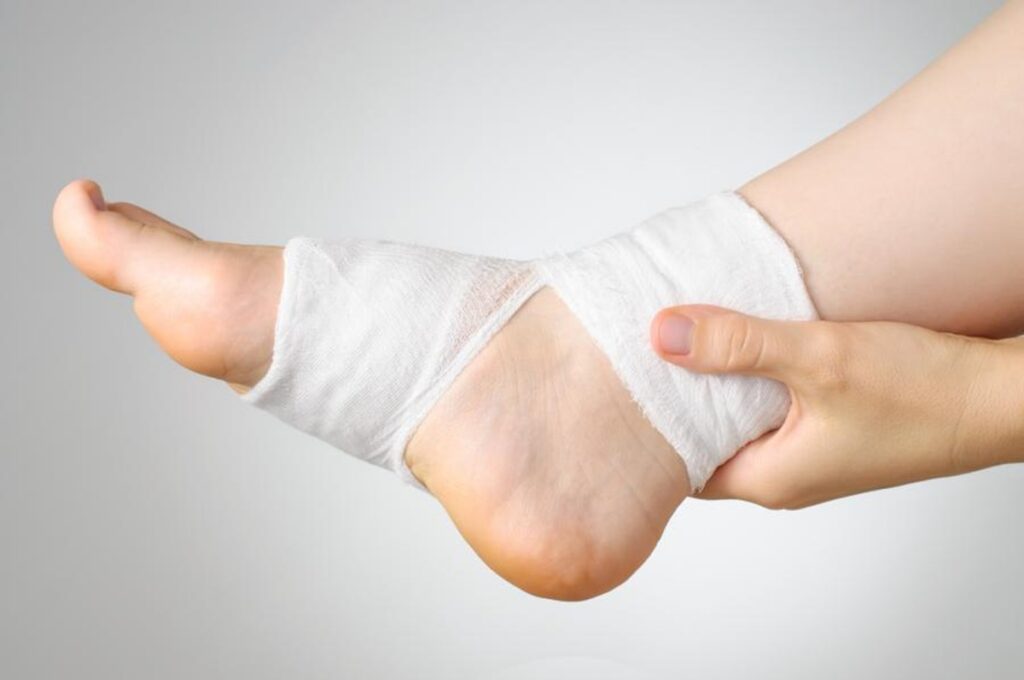An ankle sprain can happen in seconds—from a misstep on a trail to a slip during a workout—but its effects can last for weeks or even months without proper care. Many people overlook the seriousness of this ligament injury, assuming rest is enough. However, for full recovery and to prevent recurring ankle sprains, physical therapy for sprained ankle is often necessary. Professional care helps restore strength, mobility, and stability effectively.
At Scottsdale Physical Therapy & Performance, we help patients recover their strength, balance, and mobility through expert, hands-on treatment. If you’re dealing with a high ankle sprain, chronic ankle sprain, or simply want to return to sport without pain, our approach ensures long-term results.
What Is a Sprained Ankle and Why It Needs Proper Treatment
Ankle sprains are among the most frequent injuries across all levels of athletic participation. Research shows they make up around 15% of all injuries sustained in both high school and college-level team sports. Their high occurrence highlights the need for better prevention and structured care plans, especially for athletes aiming for a full return to play.The severity of injury ranges from minor stretching (Grade 1) to full ligament tear (Grade 3).
Symptoms can include ankle swelling, ankle bruising, pain when putting weight on the foot, and tenderness to the touch. Diagnostic tools such as MRI, x-ray, or other diagnostic tests may be used to confirm the extent of the damage. Whether you’re recovering from a fall, a sports injury, or trips and falls at home, physical therapy for sprained ankle helps prevent long-term complications like chronic ankle instability or chronic lateral ankle instability.
Grading the Severity of Ankle Sprains
Understanding the grading system helps patients make better health care decisions. Each grade of ankle sprain involves different levels of ligament damage, symptoms, and expected recovery time:
Grade 1 (Mild):
- Ligaments are mildly stretched, not torn
- Symptoms: light swelling, minor tenderness, stable joint
- Recovery: 1–2 weeks with rest and guided rehabilitation
Grade 2 (Moderate):
- Partial ligament tearing with some joint instability
- Symptoms: moderate pain, range of motion loss, swelling, possible bruising
- Recovery: 3–6 weeks with physical therapy exercises for sprained ankle
Grade 3 (Severe):
- Complete ligament rupture, high instability
- Symptoms: severe swelling, pain when putting weight, bruising, difficulty walking
- Recovery: 8+ weeks and may require brace, boot, or surgery

Sprain vs. Fracture: How to Tell the Difference
Sprains and fractures can feel similar, but some signs may indicate a break. Fractures often involve:
- An inability to move the ankle at all
- Intense, sharp pain at a localized point
- Visible deformity or protrusion
- Numbness or loss of circulation
While ligament injuries are serious, fractures need a different type of care. Only a qualified orthopedic doctor or healthcare provider can make a definitive diagnosis—which is why MRI, x-ray, and expert evaluation are crucial.
Why “Just Resting” a Sprained Ankle Isn’t Enough
It’s tempting to rest a sprain, wrap it in an elastic bandage, and hope it heals. While rest is important in the acute phase, relying solely on it can increase recovery time and lead to persistent pain or acute ankle instability. In some cases, improper healing results in uncoordinated leg muscles, weak leg muscles, and poor proprioception.
Our clinic often sees patients who tried crutches, ice packs, or even a boot, but never regained full ankle stability. Many delay treatment, only to deal with reinjury or loss of range of motion. Physical therapy in Scottsdale ensures healing happens the right way, reducing your need for future interventions like surgery or walking aids.
How Physical Therapy Supports Healing and Prevents Reinjury
We follow the most current evidence-based clinical guideline to support healing through every phase of rehabilitation. Each treatment plan is customized to address the specific diagnosis, age, and previous history of ankle sprain.
Proper ankle rehabilitation should follow a personalized, step-by-step plan. Early treatment emphasizes reducing inflammation, improving joint flexibility, and starting basic strength work. Once pain-free motion and weight bearing are achieved, balance training becomes essential to rebuild neuromuscular control. Advanced rehab then targets a full return to function through progressive, sport-specific movements.
Phase 1: Pain and inflammation control
This phase includes manual therapy, specialized massage, brace or splint use if necessary, and modalities such as dry needling, electrical stimulation, or ice pack treatment. In some cases, anti-inflammatory drugs like NSAIDs may be recommended under the supervision of your healthcare provider to help manage discomfort and swelling.
Phase 2: Restoring range of motion
Guided passive motions, mobility work, and stretching exercises help recover flexibility without aggravating the injury. Early motion supports long-term ankle stability and functional recovery.
Phase 3: Strength training and endurance
Therapists use sport-specific techniques, strength training, and muscular endurance exercises to rebuild ankle and leg stability. We also address weak leg muscles, uncoordinated leg muscles, and muscle imbalances that contribute to recurring ankle sprains.
Phase 4: Neuromuscular control and return to sport
We incorporate balance training, proprioception drills, and activity simulation to reprogram the ankle’s reflexes. This ensures you’re ready for your sport, hike, or active job with full control and full strength.
How to Prevent Future Ankle Sprains
Preventing a sprain is often easier than treating one. Whether you’ve had a chronic ankle sprain before or want to protect a newly healed joint, here are key ways to reduce your risk of reinjury:
- Warm up before any sports activities or workouts to prep joints and muscles
- Wear appropriate footwear that supports your arch and ankle
- Perform balance exercises and strength training regularly
- Maintain a healthy weight, which reduces load on the ankle joint
- Use braces or ankle wraps as recommended during high-risk activities
Our clinic also provides sports activities modification and long-term treatment plans to keep you moving safely. Preventive care is an important part of our Sports Performance Rehab services.
Physical Therapy Exercises for Sprained Ankle Recovery
Each recovery phase includes targeted movements that address key healing goals. These are examples of physical therapy exercises for sprained ankle rehabilitation and are often used in clinics like ours.
Early-Phase Exercises to Restore Mobility
Restoring gentle motion helps prevent stiffness:
- Ankle circles: Improve joint mobility and circulation.
- ABCs with the foot: Activates movement through multiple planes.
- Towel scrunches: Engage foot muscles and restore arch support.
These are part of a well-structured home exercise program and are especially helpful for patients with limited range of motion.
Mid-Phase Strengthening Movements
Progressive loading supports strength and balance:
- Banded resistance exercises: Target dorsiflexion, inversion, and eversion.
- Calf raises: Rebuild gastrocnemius and soleus strength.
- Heel-to-toe walking: Reinforces stride and ankle stability.
Our therapists use these tools to improve muscle strength, endurance, and reduce the risk of reinjury.
Late-Phase Stability and Return-to-Activity Training
When nearing full recovery, focus shifts to control and sport readiness:
- Single-leg balance: Enhances balance and joint responsiveness.
- Agility drills: Mimic sports motion and reinforce quick response.
- Running mechanics training: Reduces risk of sports injury recurrence.
These exercises are prescribed by our specialists in orthopedic focus and sports rehab. Every plan is unique—never self-prescribe without professional input.

What to Expect During Treatment at Scottsdale PT & Performance
From your first visit, we provide expert, results-driven care tailored to your needs. Our clinic offers:
- One-on-one 60-minute sessions with a Doctor of Physical Therapy
- Hands-on therapy, joint testing, and advanced orthopaedic care
- Functional tools like gait analysis and return-to-sport assessments
- A custom home exercise program with digital access
- Transparent timelines, realistic goals, and full recovery support
Our providers have advanced credentials, including fellowship training (FAAOMPT), and years of success in sports performance rehab and ankle injury management. If you’re looking for trusted care, Request Appointment today.
When to Seek Help—and When It’s Urgent
Mild ankle sprains can often be treated with rest and rehab. However, some signs suggest you need immediate medical attention.
Get urgent care if you experience:
- Inability to walk or bear weight after 48 hours
- Severe swelling or bruising that worsens
- Numbness, tingling, or coldness in the foot
- Obvious deformity or suspicion of a fracture
- Sharp localized pain that doesn’t improve
- A history of chronic ankle sprains or instability with a new injury
If any of these red flags are present, visit your orthopedic doctor or emergency care for evaluation. Otherwise, beginning physical therapy for sprained ankle early can significantly improve outcomes.
Why Choose a Licensed Physical Therapist in Scottsdale for Ankle Rehab
Scottsdale Physical Therapy & Performance is built on trust, expertise, and one-on-one care. Here’s why patients continue to choose us:
- Top-rated 5-star reviews from active adults and athletes
- Experience managing sports injury, post-surgical cases, and chronic instability
- Personalized programs without overbooking or rushed sessions
- Clear expectations, communication, and evidence-driven outcomes
Our clinic stands out in physical therapy in Scottsdale by offering high-touch care with real clinical results. From diagnosis to return to sports, we’re here for every step.
Conclusion
Ankle sprains vary in severity, but all deserve thoughtful treatment. Whether you’re healing from a mild twist or a severe ligament injury, physical therapy for sprained ankle offers a safe, research-backed path to healing. At Scottsdale Physical Therapy & Performance our expert team helps you recover faster and prevent future setbacks.
Ready to get back to doing what you love? Request Appointment today and start moving forward with confidence.
FAQs
How long after a sprained ankle should you start physical therapy?
Most patients benefit from beginning physical therapy for sprained ankle within 3 to 5 days of injury. Early guidance helps reduce swelling, improve range of motion, and avoid complications.
What is the fastest way to heal a sprained ankle?
The fastest recovery combines rest, mobility training, and progressive strength work. Working with a physical therapist scottsdale ensures a safe, complete recovery.
Does physical therapy work for a sprained ankle?
Yes. Evidence supports physical therapy for sprained ankle as the most effective treatment for restoring function, reducing recovery time, and preventing reinjury.









